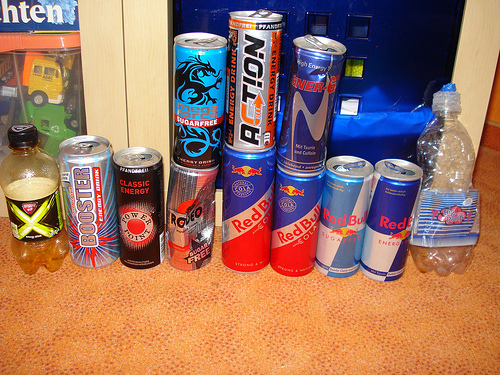By Brittni Brown (Contributor) – Email
Print Edition: February 6, 2013
Health Canada has recently imposed caffeine restrictions on energy drinks to protect Canada’s youth from potential health risks. Energy drink companies must now limit the amount of caffeine per single serving to 180 mg. Health Canada hopes this will combat many youth-related health risks which have been linked to the overconsumption of caffeine. However, this new limit still more than doubles the 80 mg maximum daily consumption recommended for children up to 12-years-old. Am I the only one seeing a discrepancy here?
This restriction isn’t going to protect children from energy drinks at all. Approved caffeine levels are still way too high for children to drink these products safely. What’s the point of making all these companies remodel their drink formulas if they are still going to have harmful effects?
Energy drinks, which were previously labelled as “health food drinks” have now been reclassified as “food” products. Of the 98 reclassified drinks, 28 must now reformulate their product to meet the caffeine, vitamin and mineral requirements of their new classification. It’s a long and expensive process, especially for one that does not protect our health. On top of this, an adult who can maturely decide he wants a caffeine boost will have to buy two energy drinks to get the same effect as a current Full Throttle energy drink – which has more than 250 mg of caffeine per serving.
Justin Sherwood, president of Refreshments Canada, reported to the Globe and Mail that this decision reflects a double standard since many beverages—such as coffee—contain equal amounts of caffeine and are equally accessible to children and teens. He argues that similar products are not required to slap warning labels on their packaging.
Did you know that one grande coffee from Starbucks has 330 mg of caffeine and a venti has 410? Did you know that the maximum recommended amount of caffeine for adults is 400 mg per day? My boss can certainly chug back three venti Starbucks coffees (all with an extra shot of espresso) in a single workday. Maybe it would be easier to cap caffeine consumption if Health Canada would just limit the amount of coffee breaks Canadian management are entitled to per day. Point being, the energy drink industry is receiving heavy flack in comparison to its competition.
Health Canada claims this will “protect” children from drinking too much caffeine in a single day. Will it really? Is there not a point where parents must take responsibility for the caffeine consumption of their own child? Ten-year-old kids are not legally allowed to work; the money to buy these products is coming from the parents’ pockets.
A business is a business, not a parent. Its purpose is to sell a product, not to babysit a child. The responsibility should not fall on energy drink companies to regulate children’s consumption of their product. Further, if new restrictions are not bold and effective enough to make a guaranteed difference, it is unnecessary for these companies take the hit – even if it does benefit the public facade of Health Canada.


